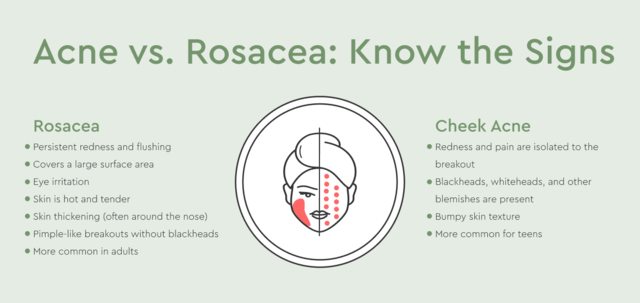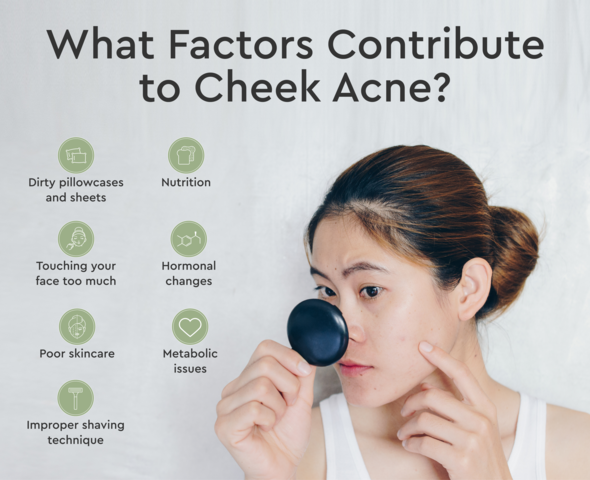How to Get Rid of Cheek Acne Overnight
How to Clear Cheek Acne
Acne is always a nuisance, whether it pops up unexpectedly right before a date or it persists for years. Most respond by using extreme and unnecessary skin treatments or by layering on makeup to hide breakouts, however that can just make things worse.
Instead of covering up the problem, take a closer where the acne is showing up on your face. Why? It turns out the location of your acne says a lot about what may be causing it. If you find that acne only occurs on your cheeks and you can't figure out how to clear up cheek acne, we have you covered. Our comprehensive guide breaks down why you might have acne on your cheeks, and how to get rid of cheek acne.
Is It Cheek Acne or Rosacea?
If you have redness, blemishes, and irritation on the side of your face, you might have cheek acne, but it could also be rosacea. Though cheek acne and rosacea are commonly confused because they exhibit similar symptoms, they require different treatments. In fact, using acne treatments for rosacea can actually make it worse.

Identifying whether you have rosacea or cheek acne is the most important part of finding the right treatment for your skin condition. If you believe you have rosacea, you should visit your dermatologist to get a diagnosis and treatment recommendations.
If you believe you have cheek acne, keep reading to get a better understanding of what's causing your breakouts and how to treat them.

Clinically Proven Acne Treatment
Tired of cheek acne? Get clearer skin in as little as 2 weeks!
Try It
What Causes Cheek Acne?
Often, U-zone or cheek acne is caused by the buildup of dirt, oil, and debris that clogs pores over time. While the T-zone—the area that includes the forehead, nose, and all the way down to the chin—is generally prone to oil, cheeks typically tend to be more dry. Often, adult acne is characterized by U-zone acne, but there are solutions available to help with breakouts.

Before we can help you figure out how to get rid of cheek acne, you need to understand the causes of acne—specifically the breakouts you're experiencing on your cheeks.

Whether you naturally have dry, combination or oily skin, cheek acne is typically a byproduct of the environment, including the following factors.
Cheek Acne Cause #1: Dirty Pillowcases & Sheets
Consider your sheets. You may not realize it, but your sheets could be a contributing factor to the pimples on your cheeks. In a short period of time, your sheets become a breeding ground for nasty fungi, bacteria, dust, dirt, pollen, and many more allergens that nestle into your sheets. Gross!
And it's not just your sheets, this includes your pillowcase. Think about it—your pillowcase touches your face, neck, and hair for about seven or more hours every night.
This means your body transfers any debris and bacteria you have carried throughout the day onto the sheets. It's possible, too, that the oil from your hair will make contact with your face, making the problem for those with oily skin worse.
Cheek Acne Cause #2: Touching Your Face
Throughout the day, our hands collect all sorts of pollutants and allergens whether we touch a keyboard, a kitchen sponge, or use our smartphone. And, the more you touch your face, the more the bacteria, dirt, and allergens make contact. Between washes, these substances have time to permeate the skin, potentially clogging your pores and contributing to breakouts.
Cheek Acne Cause #3: Poor Skincare
Many overreact to acne by scrubbing the acne on their cheeks severely. This is a mistake! The skin on our face is especially sensitive, which means you need to be gentle with it at all times.
Your skincare products may also be part of the problem. If you're using skincare products or makeup that contains ingredients like alcohol and synthetic fragrances, they may be irritating your skin or clogging your pores.
Luckily, we have the perfect solution to this problem!
We recommend the bioClarity Clear Skin Routine!
We're biased since we make this product, but it works. The Clear Skin Routine is clinically proven to treat mild to moderate acne with harsh chemicals..
Cheek Acne Cause #4: Improper Shaving Technique
Your shaving technique may be causing irritation and increasing your risk of ingrown hairs.
Keep reading to see proper shaving tips below!
Cheek Acne Cause #5: Nutrition
If you have cheek acne, your diet might have something to do with it. While the debate about the relationship between diet and acne continues, diet may be tied to acne in several ways.
It's not fun, but adjusting your diet can make a huge impact on your skin complexion.
Cheek Acne Cause #6: Hormonal Changes
As with breakouts anywhere on your face and body, hormonal changes are usually one of the biggest factors that influence when and if you experience acne.
That's why many people get their worst breakouts when they are going through puberty or pregnancy.
Cheek Acne Cause #7: Metabolic Issues
If you have metabolic issues, you may exhibit acne as one of the symptoms. This is because there is a disruption with the body's natural processes that is causing inflammation, including acne breakouts on your face.
Other factors can also play a role in developing cheek acne. Your breakouts might even be caused by stress or your workout routine. Fortunately, many of these factors are in your control.
How to Prevent Cheek Acne
Trying to narrow down how to help cheek acne or even how to get rid of cheek acne once and for all? If you believe one of the above causes is the culprit of your outbreaks, making the following changes can help get rid of cheek acne:

Cheek Acne Treatment #1: Wash Your Sheets and Pillowcases
To help get rid of cheek acne, it is recommended that you wash your sheets at least once a week to maintain healthy skin. If you are especially acne prone, try sleeping with a clean hand towel over your pillowcase, and change it out every day, or switch out the pillowcase itself. If you have long hair, tie it up on top of your head to avoid contact with your face, neck and back.
Cheek Acne Treatment #2: Avoid Touching Your Face
You should avoid touching your face as much as possible—that means you should stop resting your hands on your chin and cheeks. In addition to not touching your face, you should wash your hands frequently between activities to reduce the risk of transferring bacteria, oils, and dirt to your face.
Cheek Acne Treatment #3: Improve Your Skincare Routine
When struggling with cheek acne, your skincare routine is a great place to start. You'll want to use a combination of a few different products to ensure your skin is clean, treated, and nourished with the right ingredients.
Harsh chemicals can cause excess dryness and redness that can make your complexion even worse.
To make things easier for those struggling with acne, we created a 3-step routine that is easy to use and covers all the bases.
Learn more about our 3-step Clear Skin Routine here.
So what makes a good skincare routine for cheek acne?
Start With a Good Cleanser
First things first, you want to want to be sure to use a gentle vegan cleanser. When washing your face, you want to take care to delicately rub cleanser on your face and then pat the skin dry. The goal is to remove dirt and excess oil from the skin without irritating or over-drying it.
Washing the face may sound simple but many are doing it wrong. Learn more about how to wash your face properly.
When it comes to your skincare products, you want to use a cleanser and moisturizer that's non-comedogenic (won't clog your pores) and won't irritate your skin. Products with natural ingredients such as cucumber, green tea, and chamomile can cleanse, soothe, and refresh the skin without irritating.
You might like our gentle foaming cleanser, great for acne-prone and oily skin.
Use an Acne Treatment Product
Once you have a fresh, clean face, use an acne treatment product that treats acne without causing additional irritation.
Our favorite option is Treat - Acne Treatment Gel.
Treat is an effective, yet gentle acne treatment gel thatcombines exfoliating salicylic acid (2.0%), soothing oat kernel, and moisturizing squalane to battle blemishes without the burn.
It helps reduce current and future cheek breakouts and it helps reduce inflammation.
Soothe and Moisturize
While the acne treatment step is critical to clearing cheek acne, so is this last step. The skin also may need additional hydration and ingredients that can help soothe and calm the skin.
Our favorite option is Restore - Nourishing Gel
This nutrient-packed, gel-based treatment is designed to nourish your skin and help fight breakouts as part of our Clear Skin Routine. This green gel helps visibly reduce redness from acne, even skin tone and texture, and leaves a dewy finish.
Clean Up Your Makeup Routine
When you can't figure out how to get rid of cheek acne, it can also be tempting to layer on the makeup. While this can temporarily cover up the issue, and make you feel more confident, it could actually be doing more harm than good if you're not careful. If you're going to wear makeup to cover up cheek acne, you should:
- Always wash your face thoroughly before the gym and before going to bed
- Clean your makeup brushes regularly
- Use non-comedogenic makeup
- Use a hydrating primer like Primed & Ready to prep your skin for flawless makeup application and keep your skin hydrated all day long.
These practices can help keep the area clean and prevent buildup from clogging your pores.
Cheek Acne Treatment #4: Use Proper Shaving Technique
If you shave your face, you may be going about it wrong. Shaving your face should always be handled with care. For men especially, the hair tends to grow thicker and the pores are more prone to inflammation. To avoid ingrown hairs and acne, follow some simple steps:
- Splash warm water on your face to open pores.
- Use a shaving cream that is designed to protect your skin according to skin type. For most skin types, a single bladed razor prevents the clogging of pores with dead skin.
- Use a natural astringent such as witch hazel to leave pores feeling clean and refreshed.
When shaving, always go with the direction of the hair growth. Going against the grain may get your a closer shave, but it can lead to irritation and increase the chances of getting ingrown hairs.
Cheek Acne Treatment #5: Adjust Your Diet
If you're wondering how to clear cheek acne, making these changes to your diet may be helpful:
1. Eliminate Indigestion: Indigestion is a sign that your body is struggling to process foods properly. You may lack water, fiber or gut bacteria to digest food. This can cause inflammation, risk of food allergies, and difficulty processing sugar which will spike insulin and can contribute to excess sebum production, which can lead to acne flare ups. Hydrate, eat more fiber, and try eating probiotics like yogurt or kombucha to eliminate indigestion.
2. Reduce Sugar Intake: Decrease your intake of sugar sweets, processed carbohydrates, and sugary beverages. Replace with non-sweetened beverages and whole foods. If you love sweets, try curbing the cravings with yummy blueberries or strawberries.
3. Incorporate Leafy Greens: Essential vitamins and minerals are critical to skin health. Substances such as Vitamin E or Omega-3 fatty acids contribute to the production of skin tissues and the elimination of inflammation. The right balance of nutrition can be found in natural vegetables and greens and can make your skin vibrant and acne-free.
4. Consider Taking a Supplement: This can help correct vitamin and mineral deficiencies that can lead to skin issues but it can also help abolish aggravators, calm, and nourish the skin.
Cheek Acne Treatment #6: Take an Oral Contraceptive
There has long been a debate whether birth control helps or worsens acne. For some women, taking an oral contraceptive can help regulate hormones and help get rid of cheek acne. If you're considering taking birth control for acne, you want to choose one that has the right amount of estradiol and low levels of progestin. Before you try to control your acne with birth control, you'll want to speak with your doctor.
Cheek Acne Treatment #7: Seek Treatment for Your Metabolic Issue
Receiving treatment for metabolic dysfunction can help reduce or eliminate breakouts, including those on your cheeks, because you are relieving the underlying problem.
Often you will need to commit to several of these solutions to get rid of cheek acne.
What If My Skin Isn't Responding to These Treatments?
If your skin doesn't respond to these treatments, you should seek the help of a dermatologist. According to the American Academy of Dermatology, there are several reasons why you might not be seeing results, but a doctor may run tests to determine if you have metabolic issues or a hormone disorder that causes these problems.
You can also try DIY treatments. There are many DIY face masks, scrubs, and topical treatments that may be able to help with cheek acne but you need to be careful because certain ingredients (like lemon or baking soda) may cause irritation and worsen your breakouts.

Professional Cheek Acne Treatments
Visiting a professional when you can't figure out how to clear up cheek acne can help you ensure you receive the most effective treatment and prevent acne scars.
If these tweaks to your lifestyle aren't improving your complexion and you're still trying to figure out how to clear cheek acne, there are other ways to get rid of cheek acne. Some professional cheek acne treatments include:
Cheek Acne Treatment #8: Medication
Your dermatologist may recommend medication for severe cheek acne. Popular medications for acne include antibiotics, Isotretinoin, and Spironolactone. You may receive medication in oral or topical form.
Cheek Acne Treatment #9: In-Office Treatments
If you're stumped on how to get rid of cheek acne, in-office treatments may be your solution. Popular cheek acne treatments include:
- Chemical peels
- Laser therapy
- Facials
- Extractions
- Steroid injections
Cheek Acne Treatment #10: Dermatologist Recommended Skincare
If you experience cheek acne, you want to use high-quality skincare products, including your cleansers and moisturizers, that are designed to be effective without irritating your skin.
Following the tips in this guide—and seeking professional treatment when necessary—can help you overcome cheek acne and keep your skin clear.

Clinically Proven Acne Treatment
Tired of cheek acne? Get clearer skin in as little as 2 weeks!
Try It
Key Takeaways: How to Clear Cheek Acne
- What causes cheek acne? Cheek acne can be the result of hormones, metabolic issues, and environmental or lifestyle factors.
- How can I prevent cheek acne? Cheek acne can be prevented or cleared up by making changes to your daily routine like washing your sheets more frequently or improving your skincare routine.
- When should you see a doctor for cheek acne? If your cheek acne is not responding to any of the changes you're making or treatments you've tried at home, you should visit a dermatologist.
- Professional treatments or dermatologist recommended skincare products, like BioClarity, may be your best option to get rid of cheek acne.

Abby Vinas
Abby Vinas has long been an active member of the holistic health community, advocating in favor of its benefits to both our physical and emotional well-being. Her commitment to leading a healthy lifestyle has made her an authority on self-care practices. Abby is passionate about fitness, nutrition, and proper skincare, and is also an avid lover of avocado toast and dog-petting.
How to Get Rid of Cheek Acne Overnight
Source: https://www.bioclarity.com/blogs/clear-skin/how-do-i-get-rid-of-cheek-acne